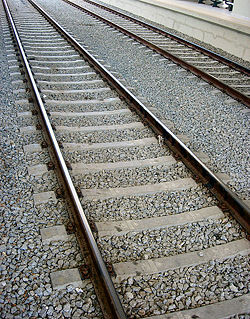Parallel (geometry): Difference between revisions
imported>Peter Schmitt (starting a rewrite) |
imported>Peter Schmitt (continued) |
||
| Line 1: | Line 1: | ||
{{subpages}} | {{subpages}} | ||
[[Image:Rail tracks @ Coina train station 04.jpg|thumb|250px|alt=Picture of railroad tracks.| | [[Image:Rail tracks @ Coina train station 04.jpg|thumb|250px|alt=Picture of railroad tracks.|Straight railway tracks may be considered as segments of parallel lines, railway tracks with curves are parallel curves.]] | ||
According to the common explanation two straight lines in a [[plane (geometry)|plane]] are said to be | According to the common explanation two straight lines in a [[plane (geometry)|plane]] are said to be | ||
| Line 14: | Line 14: | ||
* ''(Equidistant lines)'' Parallel lines have constant distance. <br> (This means, more precisely, that all distances from a point on one of them to the other line are the same.) | * ''(Equidistant lines)'' Parallel lines have constant distance. <br> (This means, more precisely, that all distances from a point on one of them to the other line are the same.) | ||
* ''(Transitivity)'' If among three distinct lines two pairs of lines are parallel then the third pair is also parallel. | * ''(Transitivity)'' If among three distinct lines two pairs of lines are parallel then the third pair is also parallel. | ||
'''Generalizations:''' <br> | |||
* Analoguously, in three-dimensional space two planes, or a line and a plane, are said to be '''parallel''' if they do not intersect. <br> In this case, no additional condition is necessary because they always belong to the "same space". (This is different, of course, if, more generally (hyper-)planes in [[Euclidean space|higher-dimensional]] spaces are considered.) | |||
* Equidistant curves are called ''parallel curves''. | |||
Revision as of 17:47, 14 April 2010
According to the common explanation two straight lines in a plane are said to be parallel (or parallel to each other) if they do not meet (or intersect), i.e., do not have a point in common.
This definition is correct if (silently) the "natural" (Euclidean) geometry is assumed.
In it, the explicit condition "in a plane" is necessary because in space two straight lines that do not intersect need not be parallel.
Non-intersecting lines that do not belong to a common plane are called skew.
Important properties of the notion "parallel" in Euclidean geometry are:
- (Uniqueness) Given a line then through any point (not on it) there is a uniquely determined line parallel to the given one.
- (Equidistant lines) Parallel lines have constant distance.
(This means, more precisely, that all distances from a point on one of them to the other line are the same.) - (Transitivity) If among three distinct lines two pairs of lines are parallel then the third pair is also parallel.
Generalizations:
- Analoguously, in three-dimensional space two planes, or a line and a plane, are said to be parallel if they do not intersect.
In this case, no additional condition is necessary because they always belong to the "same space". (This is different, of course, if, more generally (hyper-)planes in higher-dimensional spaces are considered.) - Equidistant curves are called parallel curves.
One line may be parallel to any number of other lines, which all are parallel to one another. In mathematical notation, parallel entities are symbolized by ∥, i.e. two adjacent vertical lines. Writing PQ for a line connecting two different points P and Q, this means
unless the lines AB and EF coincide. In other words, the relation "to be parallel or coincide" between lines is transitive and moreover, it is an equivalence relation.
Similarly two planes in a three-dimensional Euclidean space are said to be parallel if they do not intersect in any point. It can be proved that if they intersect in a point then they intersect in a line (or coincide). Writing PQR for a plane passing through three different point P, Q, and R, transitivity may be written as follows:
unless the planes ABC and GHI coincide. In other word, the relation "to be parallel or coincide" between planes is also transitive (and moreover, an equivalence relation).


